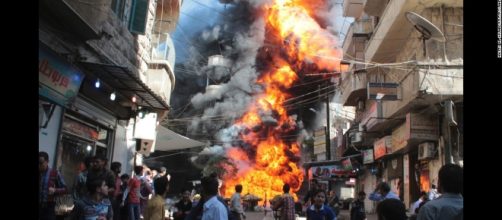No one cares about Aleppo. The only people who truly care about what is happening there are either dead or dying.
While some Syrians celebrated the victory of Assad’s troops, others recorded their goodbyes and sent said videos to major media outfits. Although the latter is dubious and reason enough for many to no longer pay attention to Aleppo, we still don’t know the real story. And this is where the conundrum begins.
The media has released an onslaught of information about Aleppo for the past few days. But even with this kind of media coverage, not many bothered to air their concerns.
The silence is deafening. Are we silent because of conflicting information? Are we silent because we don’t care about Syrians? Or are we silent because we believe US propaganda?
Four forces, one war
On one corner you have the Syrian Arab Republic and its troops supported by Hezbollah, and the Russian army. This group gets its armament support from China, Russia, Iran, North Korea, Iraq, Egypt, and Belarus.
Another group is the Syrian opposition composed of the Free Syrian Army, the Muslim Brotherhood, the Greywolves – an extremist group from Turkey, and the Free Iraqi Army. It is funded by Qatar, Turkey, the US, France, Saudi Arabia, and Libya before it fell. The Syrian opposition is also supported by a US and Turkey-led task force.
The third force is Rojava's Syrian Democratic Council. It is led by the Syrian Democratic Forces and supported by the Kurdistan Workers’ Party, the United Freedom Forces, and since 2014, the Peshmerga. Military hardware support comes from France, the US, Iraqi Kurdistan, Syria, and the Czech Republic. It is also supported by a joint task force specific for targeting the terrorist group ISIL led by the US and aided by the UK, France, Canada, Denmark, Australia, Belgium, Germany, the Netherlands, Jordan, the UAE, Bahrain, Qatar, Saudi Arabia, and Morocco. Russia also supports this third group because of two targets – ISIL and the Syrian opposition.
The fourth force is the Islamic State and the Levant (ISIL) and its allies.
Unfortunate Events
In the ‘70s, Alawite military commander Hafez al-Assad brought order to a beleaguered nation by creating a one-party state. As one would expect, many Syrians and foreign powers disapproved of his government.
Upon his death in 2000, his son Bashar became President. Reforms were initiated but most of these changes only benefited Shiites and Alawites. The gap between rich and poor widened and the Sunni majority was enraged. Unemployment among the younger generation was high and in 2007-2010, Syria experienced an intense drought that forced farmers to migrate to major cities. Syria also welcomed 1.5 million Iraqi refugees during this period making life even harder for everyone.
The Damascus Cable
America lit a fire that it can’t put out and as a consequence produced failed states out of Syria, Iraq, and Libya.
In a cable sent by William Roebuck to the White House in 2006, Roebuck wrote, “Bashar appears in some ways stronger than he has in two years. The country is economically stable (at least for the short term), internal opposition the regime faces is weak and intimidated, and regional issues seem to be going Syria's way, from Damascus' perspective. Nonetheless, there are some long-standing vulnerabilities and looming issues that may provide opportunities to up the pressure on Bashar and his inner circle.”
Possible actions included in the cable are as follows:
- Play on Sunni fears of Iranian influence
- Encourage rumors and signals of external plotting
- Highlight failures of reform
- Discourage foreign direct investment
- Highlight Kurdish complaints
What Does The US Want?
When talks of an Iran-Iraq-Syria gas pipeline started, the US formed a coalition with Qatar, Saudi Arabia, and NATO.
The Qatar-Turkey pipeline was also in the works and it would have had to go through Syria. These two pipelines would open the doors for US influence in Europe and have the continent veer away from Russia.

